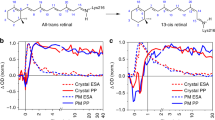Abstract
THE photoinduced intermediates of the visual photoreceptor rhodopsin have been studied by optical spectroscopy in low temperature glasses and at room temperature. The primary changes in the absorption spectrum of rhodopsin were first observed at 77 K by Yoshizawa and Kito1 then by Grellman et al.2 and Yoshizawa and Wald3. The first intermediate observed, prelumirhodopsin (bathorhodopsin) exhibits a maximum at 545 nm and has been assigned to the primary isomerisation step of the rhodopsin polyene chromophore. The room temperature kinetics of formation and decay of an intermediate species absorbing at 560 nm were measured by Busch et al.4 using picosecond spectroscopy. This original work revealed that this species, assigned as prelumirhodopsin, was formed within 6×10−2s and decayed with a lifetime of 3×10−8s. Several technical innovations in picosecond spectroscopy5–7 now enable us to monitor spectra changes between 400 nm and 1,500 nm as a function of time with ±0.02 absorbance unit resolution. We report here a complete difference spectrum for prelumirhodopsin at room temperature mapped on a picosecond time scale. These studies show that the loss of rhodopsin and the rise of prelumirhodopsin are kinetically consistent. If care is taken to avoid photon saturation no ‘ghost’ species appear in the region of 400–440 nm as has been reported previously8,9.
Similar content being viewed by others
References
Yoshizawa, T. & Kito, Y. Nature 182, 1604–1605 (1958).
Grellman, K. H., Livingston, R. & Pratt, D. Nature 193, 1258–1260 (1962).
Yoshizawa, T. & Wald, G. Nature 197, 1279–1286 (1963).
Busch, G. E., Applebury, M. L., Lamola, A. A. & Rentzepis, P. M. Proc. natn. Acad. Sci. U.S.A. 69, 2802–2906 (1972).
Netzel, T. L. & Rentzepis, P. M. Chem. Phys. Lett. 29, 337–342 (1974).
Alfano, R. R. & Shapiro, S. L. Phys. Rev. Lett. 24, 584–586 (1970).
Kaufmann, H. J. & Rentzepis, P. M. Accts chem. Res. 118, 407–412 (1975).
Bensasson, R., Land, E. J. & Truscott, T. G. Nature 258, 768–769 (1975).
Goldschmidt, C. R., Ottolenghi, M. & Rosenfeld, T. Nature 163, 169–170 (1976).
Applebury, M. L., Zuckerman, D., Lamola, A. A. & Jovin, T. J. Biochemistry 13, 3448–3458 (1974).
Tokunaga, R., Kawamura, S. & Yoshizawa, T. Vision Res. 16, 633–641 (1976).
Yoshizawa, T. & Horiuchi, S. in Biochemistry and Biophysioloqy of Visual Pigments (ed. Langler, H.) 69–81 (Springler, Berlin, 1973).
Author information
Authors and Affiliations
Rights and permissions
About this article
Cite this article
SUNDSTROM, V., RENTZEPIS, P., PETERS, K. et al. Kinetics of rhodopsin at room temperature measured by picosecond spectroscopy. Nature 267, 645–646 (1977). https://doi.org/10.1038/267645a0
Received:
Accepted:
Issue Date:
DOI: https://doi.org/10.1038/267645a0
- Springer Nature Limited
This article is cited by
-
The primary photochemical event in vision
Acta Physica Academiae Scientiarum Hungaricae (1981)





